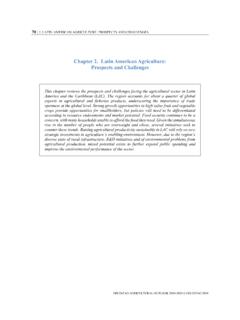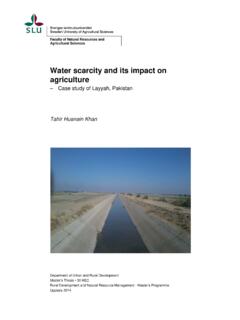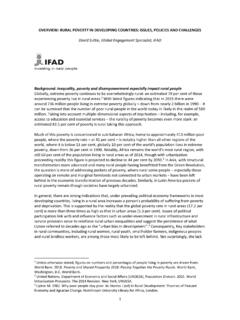Transcription of FOOD AND AGRICULTURE ORGANIZATION OF THE UNITED …
1 FOOD AND AGRICULTURE . ORGANIZATION OF THE UNITED . NATIONS. Contribution to the 2014 UNITED Nations economic and Social Council (ECOSOC). Integration Segment Food security for sustainable development and urbanization: Inputs for FAO s contribution to the 2014 ECOSOC Integration Segment, 27-29 May Between despair and hope Urban sustainability is dependent on ensuring sustainable food security and food production. Most of the world's poor live in rural areas more than three quarters to be precise while rates of malnutrition are highest among rural populations.
2 Through migration, these rural poor are among the main contributors to the rapid increase in urban population observed in most developing countries. Many of these migrants remain poor in their informal urban settlements, and face even higher food prices and greater difficulties in accessing nutritious food. Furthermore, unemployment and food insecurity among poor urban inhabitants can lead to increases in crime and unrest. We produce enough food in the world to feed everyone. Yet about 840 million people are food insecure and considered to be undernourished.
3 The global poverty rate the share of the population living on less than US$ per day has been cut in half between 1990 and 2010, achieving the MDG target set by the international community ahead of the 2015 deadline. However, about billion people continue to live in extreme poverty , and more than 75 per cent of them reside in rural areas and are primarily dependent on agricultural production. What is even more striking is that a high proportion of food insecure and poor rural people are subsistence farmers, herders, and fishers, especially in South Asia and Africa, who while struggling to survive are simultaneously called upon to play a key role in strategies to eradicate hunger and address the many challenges hampering both supply and demand for food.
4 Progress has thus been uneven, but the fact that we do produce enough food also carries a message of hope. We can end hunger. FAO is lending its support towards accomplishing this within a generation that is, by 2030. If we can strengthen the productive capacities of smallholder farmers, herders and fishers towards to that end, we can simultaneously deal with widespread poverty and food insecurity in both urban and rural areas. As we know from successful economic development experiences in recent and not so recent history, economic growth tends to be more broad-based and pro-poor when initially rooted in agricultural productivity growth and rural development.
5 China, South Korea, and Viet Nam stand out as relevant examples. However, let this message of hope not blind us from the challenges we face. While these challenges are multiple, let us focus on three in particular, and their implications for the prospects of ending hunger, reducing poverty , urban development and environmental sustainability. The three challenges are: shifting demographics; inefficient food systems; and environmental threats caused by and related to food and AGRICULTURE . Food security and sustainability challenges First is the demographic challenge.
6 In fact, there is a triple challenge associated with current population dynamics. Ongoing population growth is the first. About 78 million people are added to the world's population every year. This means that, by 2050, the global economy would need 1. to be able to provide a decent living for more than 9 billion people, of which 85 per cent will be living in what are now developing countries. Accelerated urbanization is the second element of the demographic challenge. In 2050, nearly 70. per cent of the world's population is projected to be living in urban areas.
7 This process will accelerate in developing countries in particular. This may create problems of its own, such as the challenge of creating sufficient decent jobs in urban areas. If left unaddressed, it will transfer widespread poverty and high unemployment to urban areas, especially among youth. The resulting inequity among urban inhabitants could lead to social and political instability. Growing urban populations will also place pressure on municipalities to improve their resilience to natural and human disasters.
8 Disasters can be a source of increased migration towards cities, but can also be a consequence of densely populated areas that lack access to food and water. Larger urban populations will also change food and land-use patterns a fact with potentially vast implications. Urban growth has influenced changes to dietary patterns. This is reflected in increased per capita meat consumption, which has risen by about 25 per cent over the past decade. While meat is an important source of protein, under existing livestock production methods, higher demand would lead to land-use shifts and further deforestation, higher energy use, rising food prices and regional food shortages.
9 Because of the growth of the world population and further increases in demand for high-protein food, FAO estimates that food production will need to increase by about 60 per cent from current levels. That sixty per cent increase may not be easy to achieve given the third leg of the demographic challenge: ageing. This holds in particular for farmers and rural populations. Sixty seems to be an important number here. The average age of farmers in the UNITED States and other developed countries borders on 60. In Africa, the average age of farmers is also about 60, despite the fact that 60 per cent of Africa's population is under 24 years of age.
10 So as farmers are getting older and as many of them are women with less access to productive resources, especially in developing countries this raises questions about future prospects for increasing farm productivity. Rural youth are looking for a better livelihood in the cities. Can this pattern fit a sustainable future? The second key challenge we face is that our global food system is highly inefficient. While we produce enough food, we face a double nutrition burden of under- and overnutrition. Inefficiencies are also visible in enormous food losses and food waste.














